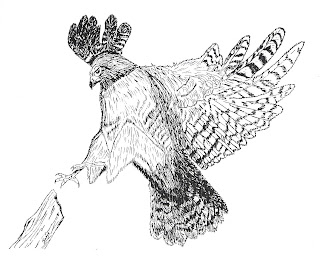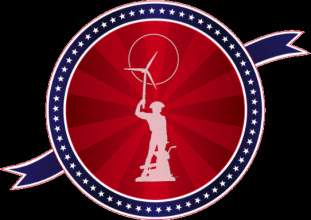I got the idea for this activity in a wonderful book of Native American teachings called Seven Arrows by Hyemeyohsts Storm, and modified it to meet my curricular needs. (It is a story in itself how this book came into my hands, but I'll save that for another blog entry.) There is a wise short story in the book called The Story of Jumping Mouse, which I occasionally use in outdoor education opportunities, but today I want to share:
A Feather in the Circle
ECOLEAD Activity #1
1. Place a feather in the center of the circle of people, or pass it around the circle. (Remember that most bird feathers are illegal to possess. I recommend using a game bird such as the Wild Turkey.)
2. Have each of the participants share the "one word" that comes to mind when they "see" the feather.(responses will range from light to dark, freedom to lost, bird to alone, etc.)
3. Discuss the responses.
4. Facilitation: I have placed a feather in the middle of our circle, and each of you responded in different ways. Why?
It is important for us to realize that each and every one of our previous experiences in life in some way affects the "way" in which we perceive this feather. For instance, one of you may be near-sighted and the feather does not appear in sharp focus, as it does for others. One of you may be seeing only one side of the feather, while another may see the opposite side. So, physical differences can influence the "way" in which you see the object.
But it doesn't stop there. One of you may have had first hand experience with a Wild Turkey, perhaps you successfully shot one of these birds during hunting season. In that case, there is an emotional experience tied to your "way" of perceiving the feather, and it is very different from the experience that the person next to you may have had with the same species while watching it spread its tail feathers in a courtship display. Or a third person may have had no experience at all associated with Wild Turkeys or their feathers.
Because of our different experiences in life, any particular object or event may appear totally different when viewed by different people. For instance, I hate roller coasters, but some of you undoubtedly love them, and some don't care one way or another. I love snakes and spiders, but some of you fear them greatly. How did that come to be? Through our own unique experiences in life, which paint the way we perceive everything in the entire world!
 |
| Summer 1986 |
So, in GLADE, this is our beginning point of reference. All the events of your life, totally unique to you, have led you to this point of convergence, where you will spend a week with these people....... in this metaphorical circle. Although we are very different from one another, we have been brought to this place in time, where we will learn and share with one another, and we will find and explore that which has brought us together.
We need every one of your perceptives to fully understand what it means for us to work together toward a common vision of a better world. We know one thing for sure, we share a love for nature and the outdoors. So we will strive to become keen sensors and observers..... eager to experience and share what Nature has to teach us about ourselves and the world around us. We await the winds that will carry us to a more lofty perch.
 |
| Summer, 1986 |
p.s. Readers, just a reminder that all the events and experiences of your life have led you to this blog today, so join in on the conversation! We need the input of all to "see" the way clearly to a just sustainable world for all....









 That is not to say that we don't have our problems. We have extremely vulnerable water due to the Karst nature of our terrain. We have the scars of overdevelopment and the remains of mountains, whose tops have been leveled for commercial development.
That is not to say that we don't have our problems. We have extremely vulnerable water due to the Karst nature of our terrain. We have the scars of overdevelopment and the remains of mountains, whose tops have been leveled for commercial development. 
 GLADE's leadership model encourages youth to make positive contributions to their communities by offering its participants grants to develop conservation action plans in their own rural towns. Our young people have set up school-wide recycling programs, water retension projects, reuseable grocery bag programs, lakeshore clean ups, children's library gardens, grow native gardens, bluebird nest box trails, and more.
GLADE's leadership model encourages youth to make positive contributions to their communities by offering its participants grants to develop conservation action plans in their own rural towns. Our young people have set up school-wide recycling programs, water retension projects, reuseable grocery bag programs, lakeshore clean ups, children's library gardens, grow native gardens, bluebird nest box trails, and more.




 Just as sure as the seasons change in the Ozarks, we will need perennial support for the GLADE project. $1000/year will provide the GLADE experience for 1 young leader/year for as many years as you are willing to support the project. Please consider a long term INVESTMENT* in GLADE.
Just as sure as the seasons change in the Ozarks, we will need perennial support for the GLADE project. $1000/year will provide the GLADE experience for 1 young leader/year for as many years as you are willing to support the project. Please consider a long term INVESTMENT* in GLADE.





 Did you know that the Hubble Telescope was named after Edwin Hubble, one of our own here in the Ozarks?
Did you know that the Hubble Telescope was named after Edwin Hubble, one of our own here in the Ozarks? Edwin Hubble was born in the small, rural community of Marshfield, Missouri, in 1889. During his life of research, he profoundly changed the way we look at our own world when he discovered that a multitude of galaxies exist beyond our own Milky Way. Rising from his humble beginnings in the rural Ozarks, he rose to become one of the greatest scientists in the world.
Edwin Hubble was born in the small, rural community of Marshfield, Missouri, in 1889. During his life of research, he profoundly changed the way we look at our own world when he discovered that a multitude of galaxies exist beyond our own Milky Way. Rising from his humble beginnings in the rural Ozarks, he rose to become one of the greatest scientists in the world.  providing direct exposure and knowledge of the wildlife, land, and water resources of the Ozarks. GLADE participants, future community leaders will take this set of skills back to their hometowns, increasing the chances of a future Ozarks communities reflecting committment to core values.
providing direct exposure and knowledge of the wildlife, land, and water resources of the Ozarks. GLADE participants, future community leaders will take this set of skills back to their hometowns, increasing the chances of a future Ozarks communities reflecting committment to core values.
 In spite of this, they enthusiastically engaged in a 2 acre Giant Cane riparian habitat restoration on a single day of the academy each year. This action both protects the waters and increases the biodiversity of the habitat so that the quality of life in the Ozarks is enhanced.
In spite of this, they enthusiastically engaged in a 2 acre Giant Cane riparian habitat restoration on a single day of the academy each year. This action both protects the waters and increases the biodiversity of the habitat so that the quality of life in the Ozarks is enhanced.  The Leadership Training aspect of GLADE incorporates the latest theories and practices in the world of business. Our niche-based approach allows each individual to flourish and rise to the occasion when there is a need for his/her input in the group process.
The Leadership Training aspect of GLADE incorporates the latest theories and practices in the world of business. Our niche-based approach allows each individual to flourish and rise to the occasion when there is a need for his/her input in the group process.  Over the course of the week, each individual develops a committment to the group, and is connected by a common vision. In this leadership model the benefits of teamwork and shared responsibility are emphasized, and the values of integrity, honesty, and respect are solidly reinforced.
Over the course of the week, each individual develops a committment to the group, and is connected by a common vision. In this leadership model the benefits of teamwork and shared responsibility are emphasized, and the values of integrity, honesty, and respect are solidly reinforced.
 I digress. The people that became my new friends last week were truly remarkable, with liquid wisdom flowing from their words and actions.
I digress. The people that became my new friends last week were truly remarkable, with liquid wisdom flowing from their words and actions. 
 Our green coalition is one that embraces all and shares a common vision of a just sustainable world. Since conservation is about people, we stand midway between the forces of continued unsustainability and an irresistible, biodiverse, dynamic, and living planet Earth. We reach our hands out, hoping that others will extend theirs to us.
Our green coalition is one that embraces all and shares a common vision of a just sustainable world. Since conservation is about people, we stand midway between the forces of continued unsustainability and an irresistible, biodiverse, dynamic, and living planet Earth. We reach our hands out, hoping that others will extend theirs to us. A gentle breeze vaporized the remnants of a tear trickling down my cheek. I plunged into the deafening silence. In an instant, or was it a lifetime, I emerged, drifting upward and outward on the thermals, as swirling winds of social and environmental change engulfed me.
A gentle breeze vaporized the remnants of a tear trickling down my cheek. I plunged into the deafening silence. In an instant, or was it a lifetime, I emerged, drifting upward and outward on the thermals, as swirling winds of social and environmental change engulfed me.